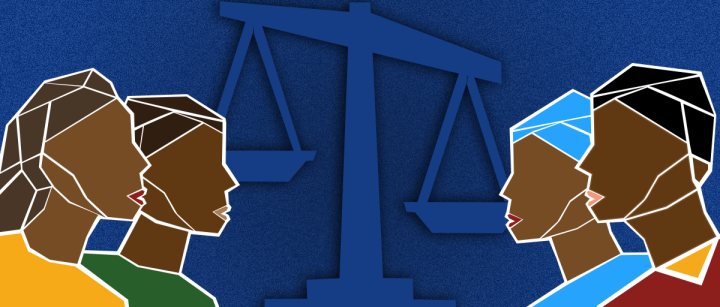ISS TODAY OP-ED
Ethiopia’s transition to democracy hinges on dialogue and transitional justice — with clear immediate goals

The challenge is balancing and integrating peace and justice for a gradual transition out of conflict.
After persistent calls to heal deep societal divides and ensure accountability for human rights violations, the Ethiopian government has declared its commitment to both national dialogue and transitional justice.
In February 2022, a National Dialogue Commission was established, and in January 2023, the Ministry of Justice released a green paper on transitional justice options. The dialogue is expected to begin in a few months, and a final transitional justice policy is pending. The two processes could overlap, although their relationship has not yet been officially established.
In principle, both are vital to facilitate Ethiopia’s democratisation and prevent further violence, but how should they be sequenced, and could they spark tensions between peace and justice? It’s also important to manage expectations about what they can achieve and how long it will take.
Ethiopia needs transitional justice and national dialogue to kickstart two long and arduous transitions from authoritarianism to a more open polity, and from a cycle of violence to greater stability.
Read more in Daily Maverick: Ethiopian peace deal must be bolstered to prevent further slaughter and war atrocities
History of conflict
The country has for decades struggled to make these transitions, and its challenges of autocracy and instability are not unique. Smooth transitions are rare, with processes instead characterised by phases of optimism, pessimism and cautious hope.
Experts were once optimistic that simply overthrowing a dictatorship was a move towards democracy. But instead of transitioning, authoritarianism often persisted. And peacebuilding scholars were hopeful about tackling the root causes of conflicts, until pessimism about the limits of conflict transformation set in.
Recently, a new wave of cautious hope has resurfaced. Scholars argued that transitions should not be assumed to culminate in either democracy or autocracy but rather be studied empirically. In the peacebuilding field, the notion of “formalised political unsettlement” introduced an alternative arrangement that “translates … disagreement at the heart of conflicts into a set of political and legal institutions for continuing negotiation”.
From the perspective of cautious hope, national dialogue and transitional justice should be understood as mechanisms that help start progressive political and security paths. They are never quick fixes or shortcuts.
How exactly do they work, and how are their roles interrelated?
The processes achieve change in three socio-political spheres: cognitive, emotive and institutional.
The cognitive involves engaging in dialogue to address fundamental societal issues and contradictions. Discussions aim to find ways to balance group rights, individual liberties, national cohesion and economic development. National dialogue is the appropriate format for this purpose.
The emotive sphere focuses on healing the wounds of past human rights violations and violence, and promoting psychological rehabilitation. The most suitable way to achieve this is through transitional justice.
The institutional sphere involves reforming existing institutions and establishing new ones to support sustainable change. Both national dialogue and transitional justice are useful here.
The three spheres are interdependent. Cognitive breakthroughs won’t lead to change without emotional healing and institutional support. Similarly, healing trauma without tackling the sources of tensions in state-society relations might not break the cycle of instability. And the success of both national dialogue and transitional justice depends on comprehensive institutional reform.
This raises the question of how to sequence the various mechanisms. Countries have followed different models, four of which are worth mentioning. The first, as in Kenya after the 2007 post-election violence, starts with dialogue and uses the agreements reached to implement transitional justice. The second, which Benin used in the early 90s, prioritises transitional justice to incentivise dialogue by offering concessions like amnesty to controversial figures.
The third model, outlined in the African Union’s Transitional Justice Policy, integrates dialogue and transitional justice into a single initiative. The fourth, of which Yemen is one case, contains a complex ordering of instruments, including amnesty, followed by national dialogue and then transitional justice elements like prosecution.
There is no ‘correct’ sequencing, and the context should determine the best approach. A combination of the third and fourth models could be useful for Ethiopia. A form of amnesty for major actors might encourage stakeholders to join the dialogue. National dialogue and elements of transitional justice, such as truth-telling and traditional conflict resolution, could then be integrated into one process, especially at the regional level within Ethiopia.
At the same time, participants could reach agreement on social justice principles and punitive measures to be administered at the federal level. These could be rolled out once the national dialogue is winding down. Such an integrated approach can help address inter-ethnic conflicts within communities, as well as state-society tensions.
Conflicting priorities
Other than sequencing, running dialogue and transitional justice together could create tensions between the goals of peace and justice. The aggressive prosecution of alleged offenders might deter those causing conflict from engaging in talks, prolonging instability. Conversely, overlooking justice can embolden those intent on using violence, leading to further attacks and exacerbating trauma and wounds.
To strike a balance, redefining justice beyond retribution is crucial. The transitional justice green paper commendably incorporates reparation and truth-telling but doesn’t cover the full range of options. Alternatives to punishment include restorative justice (victim healing through compensation rather than punishing the offender), social justice (addressing victims’ socio-economic needs), and regulatory justice (new rules of ethics and social engagement for all, not just the suspects).
The tension between justice on the one hand, and national dialogue’s goal of ‘unity’, ‘forgiveness’ and ‘synergy’ on the other, highlights the need to find a middle ground. Objectives of the dialogue process, such as achieving unity, might contradict social justice policies that restructure ethnic, class and religious relations. At the same time, such measures are not necessarily expected to facilitate inter-group harmony, at least not immediately.
Curbing expectations about both dialogue and justice is essential. In an ethnically divided country like Ethiopia, reconciliation, political settlement and radical social justice are neither feasible nor desirable immediate goals. Instead, a collective commitment to deal with disagreements in a non-violent manner, and channel conflicts through institutions (‘formalised political unsettlement’) would be a sufficiently positive goal.
Furthermore, a long and negotiated process to address unequal inter-group relations is preferable to swift and drastic measures of redress.
As an initial step, the National Dialogue Commission and transitional justice working group should agree on integrating their processes. This should happen before the dialogue is launched and the transitional justice policy is released. DM
Semir Yusuf, Project Manager and Senior Researcher, Horn of Africa Security Analysis, Institute for Security Studies (ISS) Addis Ababa.
First published by ISS Today.



















Comments - Please login in order to comment.